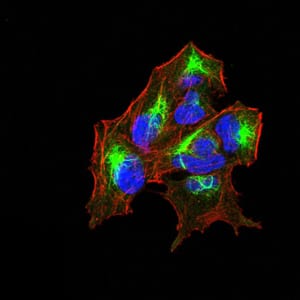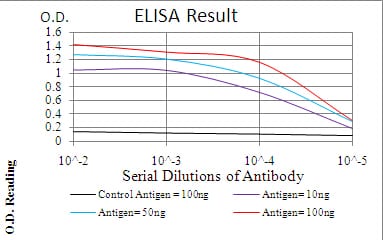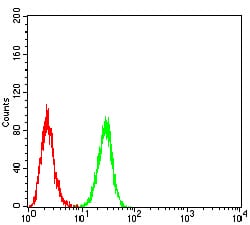


| WB | 咨询技术 | Human,Mouse,Rat |
| IF | 咨询技术 | Human,Mouse,Rat |
| IHC | 咨询技术 | Human,Mouse,Rat |
| ICC | 1/50 - 1/200 | Human,Mouse,Rat |
| FCM | 1/200 - 1/400 | Human,Mouse,Rat |
| Elisa | 1/10000 | Human,Mouse,Rat |
| Aliases | HER4; ALS19; p180erbB4 |
| Entrez GeneID | 2066 |
| clone | 4E7G5 |
| WB Predicted band size | 146.8kDa |
| Host/Isotype | Mouse IgG1 |
| Antibody Type | Primary antibody |
| Storage | Store at 4°C short term. Aliquot and store at -20°C long term. Avoid freeze/thaw cycles. |
| Species Reactivity | Human |
| Immunogen | Purified recombinant fragment of human ERBB4 (AA: 1159-1308) expressed in E. Coli. |
| Formulation | Purified antibody in PBS with 0.05% sodium azide |
+ +
以下是关于ERBB4抗体的3篇代表性文献及其摘要概括:
---
1. **文献名称**:*Structural basis for ligand-independent activation of ERBB4 via antibody-induced dimerization*
**作者**:Qiu C, et al.
**摘要**:该研究利用特异性ERBB4抗体诱导受体二聚化,通过X射线晶体学解析了抗体结合后ERBB4的胞外域结构变化,揭示了抗体介导的受体激活机制,为靶向ERBB4的抗体药物设计提供结构基础。
---
2. **文献名称**:*ERBB4 expression in breast cancer: Association with tumor subtypes and clinical outcomes*
**作者**:Sundvall M, et al.
**摘要**:研究采用ERBB4特异性抗体对乳腺癌组织进行免疫组化分析,发现ERBB4的特定剪接变体(JM-a/CYT-1)高表达与患者生存率改善相关,提示其作为乳腺癌预后生物标志物的潜力。
---
3. **文献名称**:*ERBB4 regulates cortical interneuron migration via antibody-based chemotactic assays*
**作者**:Yau HJ, et al.
**摘要**:通过阻断性ERBB4抗体干预实验,研究发现ERBB4信号通路在皮层中间神经元迁移中的关键作用,抗体抑制导致神经元定位异常,揭示了ERBB4在神经发育中的功能机制。
---
4. **文献名称**:*Therapeutic anti-ERBB4 antibodies enhance receptor degradation in lung adenocarcinoma*
**作者**:Li D, et al.
**摘要**:开发了一种新型人源化ERBB4抗体,可特异性结合受体并促进其溶酶体降解,在肺癌细胞系和异种移植模型中显著抑制肿瘤生长,为靶向ERBB4的抗体疗法提供了实验依据。
---
这些文献涵盖了ERBB4抗体在结构生物学、癌症研究、神经发育及治疗开发中的应用,反映了其多领域的研究价值。
ERBB4 (also known as HER4) is a member of the epidermal growth factor receptor (EGFR) tyrosine kinase family, which includes EGFR (HER1), ERBB2 (HER2), and ERBB3 (HER3). It plays critical roles in cell proliferation, differentiation, survival, and migration by binding to ligands like neuregulins (NRGs) and activating downstream signaling pathways such as PI3K/AKT and MAPK. Structurally, ERBB4 consists of an extracellular ligand-binding domain, a transmembrane region, and an intracellular tyrosine kinase domain. Unlike other EGFR family members, ERBB4 undergoes unique proteolytic processing, generating soluble intracellular fragments that can translocate to the nucleus and regulate gene expression.
ERBB4 antibodies are essential tools for studying its expression, activation, and functional roles in both physiological and pathological contexts. These antibodies are widely used in techniques like Western blotting, immunohistochemistry (IHC), and flow cytometry to detect ERBB4 protein levels, phosphorylation status, and localization in tissues or cell lines. Dysregulation of ERBB4 is implicated in various cancers (e.g., breast, lung, and melanoma), neurodevelopmental disorders, and heart diseases, making it a potential therapeutic target. For instance, monoclonal antibodies targeting ERBB4 are explored for their ability to block ligand binding or receptor dimerization, thereby inhibiting oncogenic signaling. However, ERBB4's role remains context-dependent, acting as either a tumor suppressor or promoter depending on splice variants and cellular microenvironment. Research using ERBB4 antibodies continues to clarify its dual functions and therapeutic potential.
×